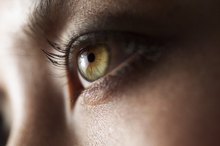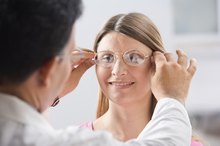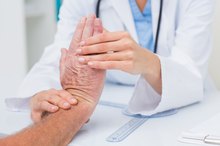Dark Skin Color & Vitamin D
Vitamin D is made by your skin when it is exposed to the ultraviolet light of the sun. Sunscreen use, seasonal changes and time spent outdoors can alter vitamin D levels. Darker skin contains more melanin, which equates to greater protection against ultraviolet radiation exposure. Because of this protective effect, people of color must spend more time in the sun to make vitamin D compared to those with lighter skin colors.
Ultraviolet Light and Vitamin D
As little as five to 30 minutes of unprotected skin exposure to sunlight can produce adequate amounts of vitamin D, according to the Office of Dietary Supplements. Your skin has receptors that take the ultraviolet radiation from the sun and make vitamin D. Your kidneys activate the vitamin D to increase your bones' absorption of calcium.
Measuring Vitamin D
How Can Eye Color Change With Mood?
Learn More
Vitamin D, or calcidiol, has a half-life -- meaning it stays in your blood for 15 days before half of the level is gone. This is a strong indicator of how well your body is manufacturing vitamin D for bone development and your overall well-being. Yet, calcidiol is inadequate in reflecting vitamin D stores in the body. Cholecalciferol, which is the active form of vitamin D that increases calcium deposits in the bone, has a half-life of 15 hours and the levels are usually not affected until severe deficiency is present.
Skin Color
Stanford University osteoporosis expert Robert Marcus writes in "Osteoporosis, Volume 1" that studies have found no difference in dark skin tones making vitamin D compared to lighter skin tones. Marcus states that darker skin color has a protective affect against ultraviolet radiation exposure, but doesn’t inhibit vitamin D synthesis. Those with darker skin tones must spend more time exposed to the sun to make the same amount of vitamin D as those with lighter skin tones. Tropical climates increase vitamin D concentrations in the blood, but people with dark skin color may make less vitamin D because of decreased exposure and the radiation strength of the sun.Those with darker skin tones living in nontropical regions have less calcium loss compared to lighter skin tones. This could be attributed to higher cholecalciferol levels that increase calcium retention and deposition of the bone.
Bone Density
Human Eye Shape Types
Learn More
Lack of active vitamin D increases the risk of bone malformations in children and softening of adult bones. Darker skinned people, specifically descendants of the African Diaspora, have a low risk of developing osteoporosis despite having low vitamin D levels. According to Marcus, African Americans have lower vitamin D concentrations, but higher intestinal calcium absorption and higher cholecalciferol, which is the active vitamin D that increases calcium deposits in the bone. Mexican-American females have higher bone density, higher parathyroid activity and equal levels of vitamin D as Caucasian females.
Osteoporosis Rates
Bone mineral densities among Americans have been compared extensively. African Americans lose bone density at half the rate of whites, despite whites requiring less sunlight exposure to make adequate amounts of vitamin D, according to Marcus. Eskimo bone mineral density has been studied and found to have a lower bone density, but a lower fracture rate of the hip.
Related Articles
References
Writer Bio
Cydney Walker is a registered dietitian and personal trainer who began writing about nutrition and exercise during her dietetic internship in 2000. She has been featured in "Voices" and by the National Medical Association for her HIV research. She earned her master's degree in human sciences from Texas A&M University in Kingsville.








